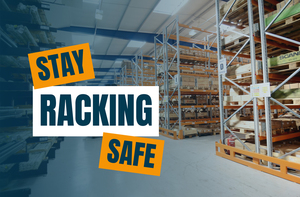

|
Edward Lowton
Editor |


|
| Home> | Handbooks | >Maintenance Management Guide | >How to Stay Racking Safe |
| Home> | Handling and Storing | >Safer manual handling | >How to Stay Racking Safe |
How to Stay Racking Safe
05 September 2025
IF YOU'RE the manager or owner of a facility with racking - would you agree with the following:

- I’m not legally responsible if a racking accident happens
- The safety of my racking is a job left to the supplier
- My racking is safe because I book my Expert Inspection
If you said ‘correct’ to any of the above, it might be time to check if you’re meeting all your racking requirements.
Keeping employees safe at work isn’t optional – it’s a legal requirement. Yet one of the most overlooked risks is that largest structure filling your warehouse or manufacturing unit - your racking. Every day it holds tonnes of stock above the heads of your employees but it can only do its job properly if it’s installed, inspected and maintained correctly. To protect your employees and your business, it makes sense to follow best practice over the lifetime of your racking. Here are some steps you should be following.
Am I legally responsible if a racking accident happens?
As you would expect there are numerous Health & Safety Executive (HSE) documents which relate to the running of a safe warehouse - from the Health and Safety at Work Act to Work at Height Regulations and Manual Handling Operations Regulations. Your racking is classed as ‘work equipment’ which means several of these documents will apply. For example, Provision and Use of Work Equipment Regulations (PUWER) expects you to inspect and maintain your racking.
The complexity of your storage equipment requires you to reference two other key documents - HSG76 Warehousing and Storage: A Guide to Health and Safety by the Health & Safety Executive (HSE) and SEMA Codes. HSG76 by the HSE covers all stages of warehouse operation including manual and mechanical handling, site transport, working at height and racking. SEMA Codes are critical in ensuring products are designed, installed, maintained, and repaired to meet quality standards and safety requirements.
While it’s not a legal requirement to follow HSG76 or SEMA Codes, it may prove problematic if an accident happens concerning your racking. If the HSE take enforcement action they can reference both frameworks to bring action against your business which may result in hefty fines or even prison.
Can I leave the safety of my racking to the supplier?
This is not a simple question to answer. Yes, it’s your supplier’s responsibility to ensure the racking’s design, supply and installation meets standards set out in SEMA Codes or the European Code EN 15512. But how do you know they meet these requirements? After all, a flashy website might look impressive, but it doesn’t guarantee safety.
As the client, you must check the supplier complies with design and industry requirements. Are they meeting British Standards? Do they have correct Health and Safety measures in place? Do they use trained installers? You will also need to look at smaller details such as how they review and correct quality performance and what employee training they undertake.
Checking these credentials does take a lot of legwork, but they’re essential for protecting your business. One way to save a lot of time and effort is to work with suppliers who have been independently audited, such as our SEMA Approved Members. This checks they meet necessary industry requirements.
What should I know about racking inspections?
As the warehouse owner or manager, you need to adopt a continuous approach to racking inspections as recommended by SEMA and the HSE.
- Person Responsible for Racking Safety (PRRS)
Nominate a member of your team to take on the role of PRRS who’ll be responsible for racking safety in the warehouse. They will ensure you meet legal requirements by taking responsibility for monitoring rack inspections, analysing damage data, identifying where regular incidents occur and then implement actions to mitigate risks.
- Immediate Inspections
Provide training for employees working in areas with racking so they can recognise damage on the equipment and then report their findings to the PRRS.
- Visual Inspection
A competent member of your team to undertake visual inspections. They are responsible for identifying structural damage, wear and tear and checking loading procedures are followed. They’ll also be responsible for writing an inspection report which forms part of your official maintenance documentation. To prepare a member of your team for the role of PRRS and conducting visual inspections you will need to send them on a training course such as SEMA’s Rack Safety Awareness course.
- Expert Inspection
This inspection should be conducted at least once a year by a qualified professional such as a SEMA Approved Racking Inspector (SARI). Be aware that not all Expert Inpsections are equal. Many industry-standard “Damage-only” inspections list damaged items and possibly their location. However, an inspection by a SARI offers far more insight by identifying racking type, equipment compatibility, damage, floor fixing suitability and minor issues. Significantly for warehouse owners, their report adopts a traffic-light system, outlining damage levels and timescales for repairs.
- Racking Repairs
Don’t take racking repairs lightly. Give your PRRS the authority to action any repairs that flag up on your Visual and Expert inspections. You should also ensure that any repairs are carried out within the set timescale indicated on the reports otherwise it could result in severe penalties by the HSE.
Raising Standards Industry-wide
You may not realise it, but it’s highly likely that SEMA’s work has already contributed to the safety of your racking. For over 50 years we’ve been raising standards across the industry, from developing Codes of Practice and technical guidance that informs on the safe pallet racking to delivering training programmes or supporting association of Members who commit to best practice. Each step feeds directly into the safety of your warehouse or manufacturing unit.
If you’re a warehouse owner and want more information on helping your racking to stay safe, visit www.sema.org.uk/warehouse-racking-safety-guide/ and download our FREE step-by-step guide to implementing safety across the lifetime of your racking.
Storage Equipment Manufacturers Association
Tel: +44 (0)1543 278489
Email: [email protected]


















